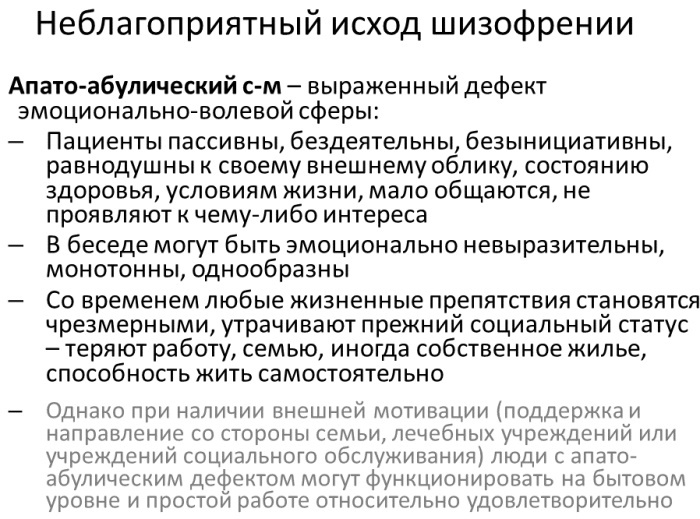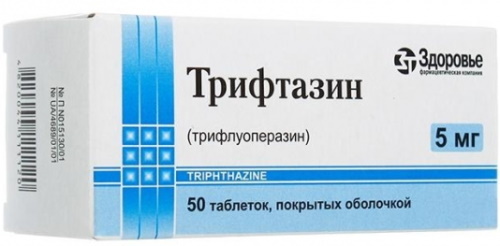A psychopathology called apathic-abulic syndrome (AAS) is quite common today. It is a disorder that characterized by a disorder of the emotional state of a person.
Patients describe it as complete indifference to the world around them. Without timely intervention, a person increasingly isolates himself from others. In this case, two violations are diagnosed at once: apathy and abulia.
Record content:
- 1 What is this disease, the nature of the term, the essence
- 2 Stages
- 3 The reasons for the development of the syndrome
-
4 The main symptoms
- 4.1 Features of the emotional background
- 4.2 Physiological manifestations
- 4.3 Propensity to act affectively
- 4.4 Motor skills
- 5 Methods of treatment and correction of the syndrome
- 6 Video about AAS
What is this disease, the nature of the term, the essence
Apathy is the so-called emotional impoverishment. Its main manifestation is the lack of even a minimal interest in life. At the same time, a person does not pay attention to either positive or negative events.
He also no longer wants to make decisions on his own. In turn, abulia is a manifestation of weakness, as well as spinelessness. That is, there is no purposeful action on the part of the patient.
The most detailed description of this disorder was published in 1958. In the work on psychology, it was indicated that apathic-abulic syndrome is characterized by a sharp drop in energy potential. If we compare what kind of life a person led before the development of pathology and after, then clear differences in behavior are visible.
At the same time, the specialists conducted interviews with the patients' relatives and took into account their opinions. In the course of research, it was also possible to find out that negative transformation does not occur immediately, but accumulates gradually. If you notice the moment when the first serious changes appeared, then you can exclude the pathological scale of such a psychological deviation.
Stages
Apathy-abulic syndrome is a disorder that can manifest itself in a variety of ways. There are 4 types of pathology.
| AAC type | Short description |
| Hypobulia | The patient's motives abruptly disappear. |
| Hyperbulia | The person, on the contrary, becomes hyperactive. |
| Parabulia | Serious behavioral abnormalities are observed. |
| Abulia | Complete loss of desire to perform any action. |

The disease can manifest itself in a short-term, intermittent, and in more complex situations, in a permanent form. The latter, as a rule, forms after the patient has been diagnosed with schizophrenia or suffered from severe brain injury.
The periodic form is more common in people with addiction (for example, alcohol) or with a manic tendency. Permanent AAS is formed on the basis of persistent (chronic) nerves and other mental disorders. Often abulia proceeds simultaneously with bouts of apathy. In this case, we are talking about apato-abulic syndrome.
Also, AAS can take two forms:
- Lightweight. The patient does not develop a pathological type of laziness. But at the same time, he does not show any interest in others. Despite a clear decrease in a person's productivity, he can still be attracted to various types of activities. A mild form of AAS can develop after prolonged depression. Doctors predict a favorable outcome, since at this stage it is possible to develop a therapy regimen that demonstrates good efficacy.
- Heavy. With this type of AAS, the patient cannot be forced to do anything. He wants to spend all the time all alone, he sleeps more often. Complete burnout of the personality is demonstrated. The only action that can be forced to do a person is to eat. In the most difficult cases, the patient refuses to do even this. If the pathology has reached this stage, then treatment is possible, but it will be long, and recovery will be slow.
Apathy-abulic syndrome is a pathology that significantly reduces the quality of human life. Gradually, he begins to degrade, loses close friends and relatives. The authority is completely lost. Therefore, it is important to timely identify the pathology and determine the causes of its appearance.
The reasons for the development of the syndrome
Most often, AAS develops in those who initially had certain mental disorders. Often, pathology is diagnosed with schizophrenia, Parkinson's disease or Alzheimer's.
Also, this syndrome is often diagnosed when several parts of the brain are damaged, which are responsible for motor, thinking or speech functions. With such disturbances in the activity of the brain, pathologically dangerous processes can develop.
Often, AAS develops due to:
- complications from head trauma or stroke;
- cerebral hemorrhage;
- the rapid development of a tumor process in the brain;
- exposure to aggressive, poisonous or toxic substances;
- long-term use of cannabinoids, that is, drugs of the psychoactive group;
- prolonged use of alcoholic beverages or drugs;
- hormonal imbalance (in particular, with a lack of dopamine);
- hereditary predisposition to mental disorders.
As with other mental disorders, AAS can be caused by other causes. Sometimes several factors act at once. Mostly adolescents 13-15 years old suffer from this syndrome.
The main symptoms
Apatico-abulic syndrome is dangerous because if it develops in a teenager, it is often attributed to the period of growing up, when there is a serious behavioral change.
Most often, teachers suggest that worried parents wait until the situation is resolved on its own and the teenager is finally formed. Some people prefer some forms of punishment as educational methods.
But it is important to understand that if we are talking about AAS, then there is no need to waste time. It is better to consult a specialist. Perhaps the teenager already needs medical help and drug therapy. Otherwise, there is a risk of developing a personality disorder. Therefore, it is worth paying attention to the main signs of AAS.
Features of the emotional background
Typically, patients with this disorder categorically refuse to leave the house. Even in an apartment, they prefer to confine themselves to a bed. At the same time, a person makes such a decision completely consciously. It seems to him that contact with other people is not something necessary. Also, the patient demonstrates a complete absence of emotions, no manifestations of curiosity.




Another violation is the development of pathological laziness. Each movement is given with great difficulty, although the person has no physiological abnormalities. It just seems to the patient that every action is too tedious. It comes to the point that people refuse to change clothes, take a shower, brush their teeth.
In an advanced stage, a person with AAS may even begin to relieve themselves in bed and continue to sleep in it and spend the whole day. At the same time, patients do not experience any dislike of unpleasant odors. Doesn't cause any emotions and own disheveled appearance.
Burnout develops over time. That is, the patient loses the opportunity to empathize or rejoice for the success of others. Even if someone has a significant event in the family, the person with AAS will not react to it at all.
In more difficult cases, if relatives try to get in touch with the patient, he may become aggressive. Such hostility can be dangerous to be in the same room as a sick person. Therefore, experts recommend exercising caution and not insisting on communication.
Physiological manifestations
If we talk about concomitant physiological disorders, then most often they manifest themselves in facial expressions. The patient's voice, intonation changes. The speech sounds unemotional. The loss of habitual autonomic reactions is also diagnosed. This means that a person may suddenly turn pale or blush.
In patients, gesticulation almost completely disappears. It may be mild, but gradually the situation becomes more complicated. It is also worth paying attention to the fact that with the development of AAS in a person, higher needs disappear and, conversely, lower needs are activated.
This means that a patient with such a disorder often exhibits excessive hypersexuality and gluttony. At the same time, he continues to exclude hygiene measures and does not see anything unnatural in this. But as soon as it comes to normal communication, the patient again loses all interest.
Propensity to act affectively
We are talking about actions that cannot be explained from the point of view of logic, since an ordinary person usually does not do this. Affective actions include urination and defecation in bed, rudeness, complete absence of shame.
In difficult situations, it can reach completely shocking actions. For example, the patient may meet guests naked or even throw excrement at them. As the disease progresses, actions become more and more shocking.
Motor skills
In patients suffering from AAS, not only motor skills can fade away. In some cases, on the contrary, they have frequent involuntary movements. At the same time, the activity becomes obsessive.
For example, a person, without noticing it, can constantly tap his fingers on surfaces, twitch his limbs or cough intermittently. If you point him to such movements, then he will be sure that this is not true, and he behaves completely normal.
Methods of treatment and correction of the syndrome
Apathy-abulic syndrome is a disorder, when the first signs of which appear, you should immediately seek medical help. Otherwise, the patient's mental state will first worsen, and then health problems will appear (due to improper diet, lack of mobility, etc.).
Previously, the specialist must conduct a complete diagnosis and identify possible mental disorders, which caused the rapid development of AAS. Most often, based on the research results, complex therapeutic measures are prescribed that are aimed at mitigating the manifestations of the syndrome.
A psychiatrist, a physiotherapist and a neurologist are involved in diagnostics and treatment. Sometimes you need additional help from a speech therapist, psychologist or exercise therapy instructor. This is due to the fact that the patient will need to undergo rehabilitation if the cause of the development of AAS is a brain tumor, stroke, or trauma.
The main diagnostic problem is associated with the fact that the syndrome proceeds without complaints from the patient. Due to the development of AAS, he is not able to independently determine the presence of deviations, since his condition does not bother him at all. Therefore, most often it is the relatives who turn to the specialists.
In most cases, a visit to a doctor takes place only after relatives practically forcibly bring a person to a medical institution or call an ambulance. Only after persistent questioning of the doctor can at least some results be achieved and preliminary data on the patient's condition can be obtained.
For a more detailed diagnosis, an MRI or CT scan is required. Thanks to ultrasound methods, it is much easier to identify previous injuries or diseases that could provoke AAS. Additionally, neurological tests are performed, a laboratory blood test is done.
It is important to eliminate the negative consequences and achieve complete recovery of not only mental, but also physical condition. If patients show serious signs of deep depression, then they cannot do without antipsychotics and antidepressants (they are prescribed strictly by a doctor).
Most often, a specialist prescribes:
- Penfluuridol. A long-acting antipsychotic, which is explained by a slow metabolism of the drug. The effect after a single dose of the drug can last up to 1 week. Available in pill form, dispensed in pharmacies exclusively on the prescription of the attending physician.
- Frenolone. It is prescribed for psychomotor retarded against the background of the development of schizophrenia. Available in the form of a pill or solution for injection. The drug is contraindicated in kidney or liver diseases. The product must be taken twice a day. The course of treatment is prescribed by a doctor.
-
Triftazin. The neuroleptic is prescribed for various mental illnesses, psychomotor overexcitation. Helps to cope with frequent neuroses, panic attacks. The drug must be taken twice a day. The course of treatment usually does not exceed 2-3 weeks. When depressed, Triftazin is prohibited.

Exercises in which the patient's relatives and friends take part are highly effective. Previously, the specialist conducts a conversation with them and explains how they should react to the patient's behavior. Their task is to exclude the likelihood of a conflict situation as much as possible.
Various psychotherapeutic methods are widely used in the treatment of this syndrome. Since it is required to correct the correct behavioral model in a person, group or individual sessions with a psychologist can be conducted.
In the case of a severe course of the disease, the patient actually has to re-learn to take care of himself, restore communication skills and the ability to cope with everyday tasks.
To restore mental balance, it is recommended to take therapeutic relaxing baths, undergo a course of restorative massage. Also, visits to the pool show high efficiency. If there are appropriate conditions for this, and the patient is not dangerous to others, then such classes are conducted with other patients.
An important step is the prevention of AAS, since otherwise there is a high risk that the syndrome will return.
To exclude such a possibility, it is necessary:
- Give preference to an active life position. This should not be influenced by age or other factors and circumstances. To do this, you can perform special psychological exercises, do breathing exercises, take relaxing baths.
- Take part in family activities. However, it can affect both work skills and rest.
- Carry out daily chores. However, they should be monitored and evaluated by other family members or by the patient himself.
- Doing spot to train willpower as well as responsibility. Also, sports events will keep you in good shape.
- Choose for yourself a creative hobby or just a business that arouses interest and do not give it up.
At the same time, the patient's relatives should not show excessive concern or, conversely, complete indifference. It is important that the person who has undergone AAS is in a normal atmosphere and does not feel like everyone else.
With timely treatment of apathic-abulic syndrome and the implementation of all recommendations, patients recover rather quickly. But it also depends on the stage of the syndrome. If the situation is neglected, it may take more time. Sometimes some behavioral functions are never restored.
Video about AAS
Schizophrenia. Apathy-abulic syndrome:



